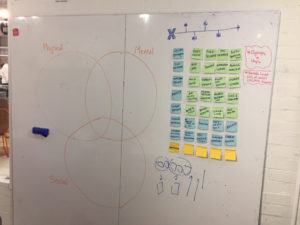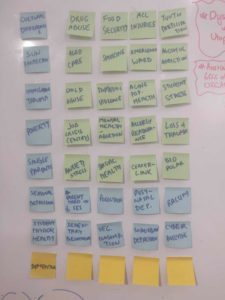To acquire a broader range of knowledge, we did research and brainstorming at this stage to keep us in the divergent approach.
We kept researching on the idea and targets of SDG-3. SDG-3 looks at a broader scope of global problems, such as infectious diseases, non-communicable diseases, etc.
At the same time, we also explored the health and well-being planning happening in Melbourne city to understand local health and well-being issues. Besides, we had a look on the health and well-being planning of other metropolis in the world, such as Tokyo, New York, London, etc. to understand the pressing health issues and possible solution in different cities.
Brainstorming
We did brainstorming this week to explore the existing and potential health and well-being issues in Melbourne city.

Opportunity space updates
After brainstorming, we came out with thirty-five potential health topics across physical, mental, social factors as listed below:


Key Learning & Insights
Look at ‘Good Health and Well-being’ in a comprehensive scope.
This is how the WHO defines health: Health is a state of complete physical, mental and social well-being and not merely the absence of disease or infirmity. —WHO

Health issues are not only limited to physical health. In developing the quality of a healthy city report, they also include several intangible aspects such as inclusiveness of community, the connection between culture and people, etc.
The health and well-being issue is multifaceted and interconnected.
To dive deeper into the topic, instead of focusing on the outcome of the problem or lifecycle, we decided to focus on an earlier stage in the life cycle.

What’s next
1. Look into the cause of health and well-being issues happening in Melbourne.
2. Develop twenty-one opportunity cards based on the health and well-being issues which are potentially pressing in 2030.
3. Look into details of health and well-being planning of other metropolis in the world as well as their solutions to create a data base for our ideation.

Recent Comments